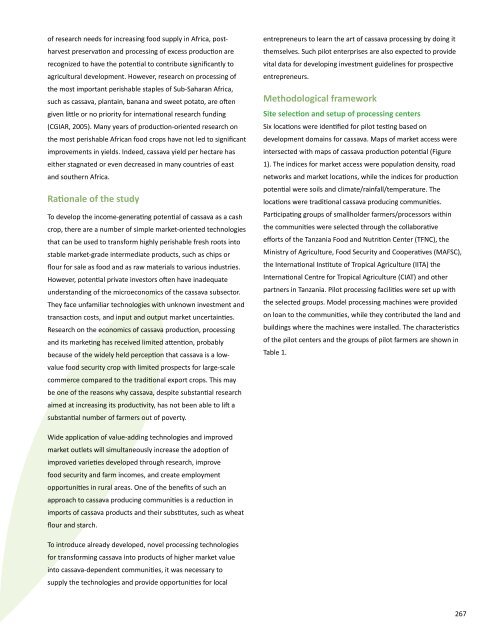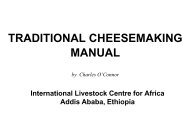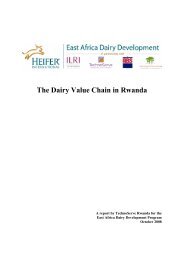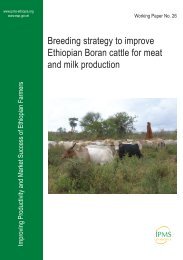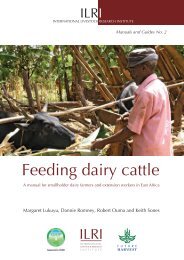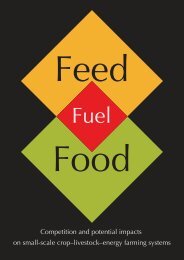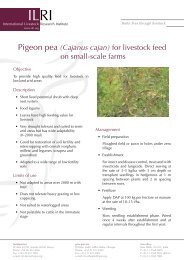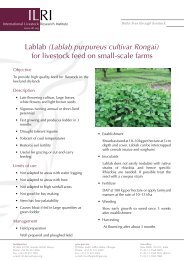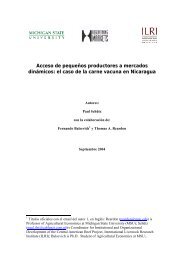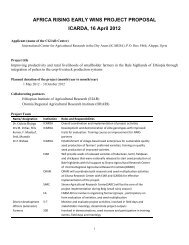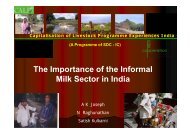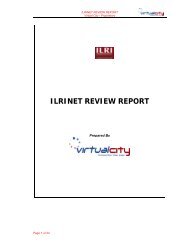High-Value Commodities and Agroprocessing - International ...
High-Value Commodities and Agroprocessing - International ...
High-Value Commodities and Agroprocessing - International ...
You also want an ePaper? Increase the reach of your titles
YUMPU automatically turns print PDFs into web optimized ePapers that Google loves.
of research needs for increasing food supply in Africa, postharvest<br />
preservation <strong>and</strong> processing of excess production are<br />
recognized to have the potential to contribute significantly to<br />
agricultural development. However, research on processing of<br />
the most important perishable staples of Sub-Saharan Africa,<br />
such as cassava, plantain, banana <strong>and</strong> sweet potato, are often<br />
given little or no priority for international research funding<br />
(CGIAR, 2005). Many years of production-oriented research on<br />
the most perishable African food crops have not led to significant<br />
improvements in yields. Indeed, cassava yield per hectare has<br />
either stagnated or even decreased in many countries of east<br />
<strong>and</strong> southern Africa.<br />
Rationale of the study<br />
To develop the income-generating potential of cassava as a cash<br />
crop, there are a number of simple market-oriented technologies<br />
that can be used to transform highly perishable fresh roots into<br />
stable market-grade intermediate products, such as chips or<br />
flour for sale as food <strong>and</strong> as raw materials to various industries.<br />
However, potential private investors often have inadequate<br />
underst<strong>and</strong>ing of the microeconomics of the cassava subsector.<br />
They face unfamiliar technologies with unknown investment <strong>and</strong><br />
transaction costs, <strong>and</strong> input <strong>and</strong> output market uncertainties.<br />
Research on the economics of cassava production, processing<br />
<strong>and</strong> its marketing has received limited attention, probably<br />
because of the widely held perception that cassava is a lowvalue<br />
food security crop with limited prospects for large-scale<br />
commerce compared to the traditional export crops. This may<br />
be one of the reasons why cassava, despite substantial research<br />
aimed at increasing its productivity, has not been able to lift a<br />
substantial number of farmers out of poverty.<br />
Wide application of value-adding technologies <strong>and</strong> improved<br />
market outlets will simultaneously increase the adoption of<br />
improved varieties developed through research, improve<br />
food security <strong>and</strong> farm incomes, <strong>and</strong> create employment<br />
opportunities in rural areas. One of the benefits of such an<br />
approach to cassava producing communities is a reduction in<br />
imports of cassava products <strong>and</strong> their substitutes, such as wheat<br />
flour <strong>and</strong> starch.<br />
To introduce already developed, novel processing technologies<br />
for transforming cassava into products of higher market value<br />
into cassava-dependent communities, it was necessary to<br />
supply the technologies <strong>and</strong> provide opportunities for local<br />
entrepreneurs to learn the art of cassava processing by doing it<br />
themselves. Such pilot enterprises are also expected to provide<br />
vital data for developing investment guidelines for prospective<br />
entrepreneurs.<br />
Methodological framework<br />
Site selection <strong>and</strong> setup of processing centers<br />
Six locations were identified for pilot testing based on<br />
development domains for cassava. Maps of market access were<br />
intersected with maps of cassava production potential (Figure<br />
1). The indices for market access were population density, road<br />
networks <strong>and</strong> market locations, while the indices for production<br />
potential were soils <strong>and</strong> climate/rainfall/temperature. The<br />
locations were traditional cassava producing communities.<br />
Participating groups of smallholder farmers/processors within<br />
the communities were selected through the collaborative<br />
efforts of the Tanzania Food <strong>and</strong> Nutrition Center (TFNC), the<br />
Ministry of Agriculture, Food Security <strong>and</strong> Cooperatives (MAFSC),<br />
the <strong>International</strong> Institute of Tropical Agriculture (IITA) the<br />
<strong>International</strong> Centre for Tropical Agriculture (CIAT) <strong>and</strong> other<br />
partners in Tanzania. Pilot processing facilities were set up with<br />
the selected groups. Model processing machines were provided<br />
on loan to the communities, while they contributed the l<strong>and</strong> <strong>and</strong><br />
buildings where the machines were installed. The characteristics<br />
of the pilot centers <strong>and</strong> the groups of pilot farmers are shown in<br />
Table 1.<br />
267


